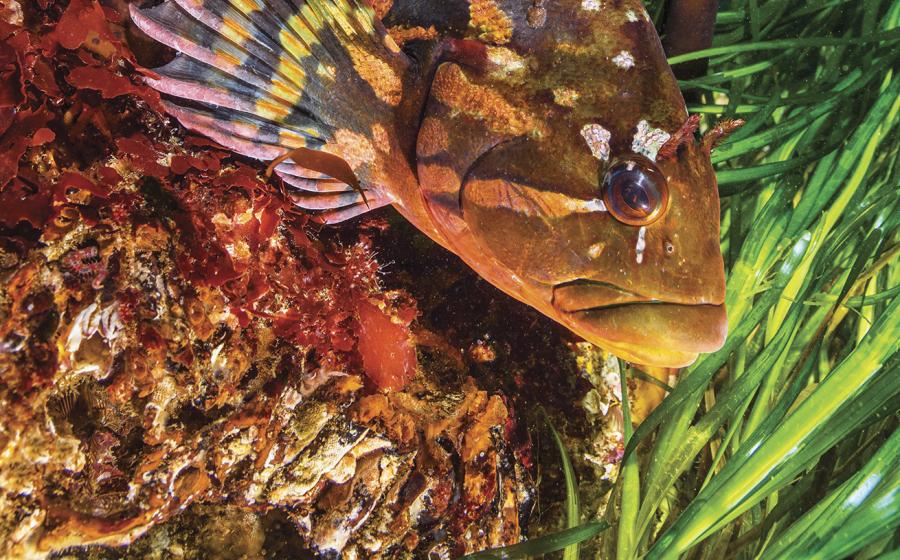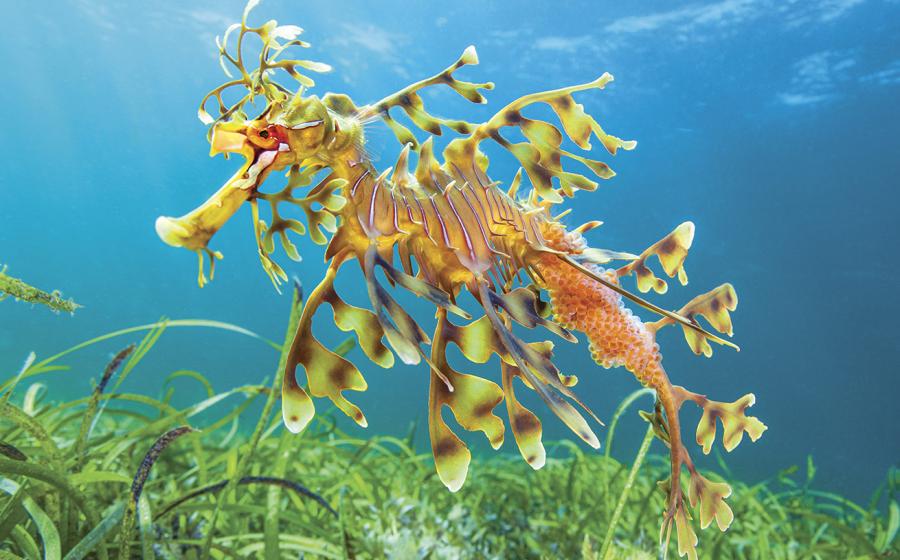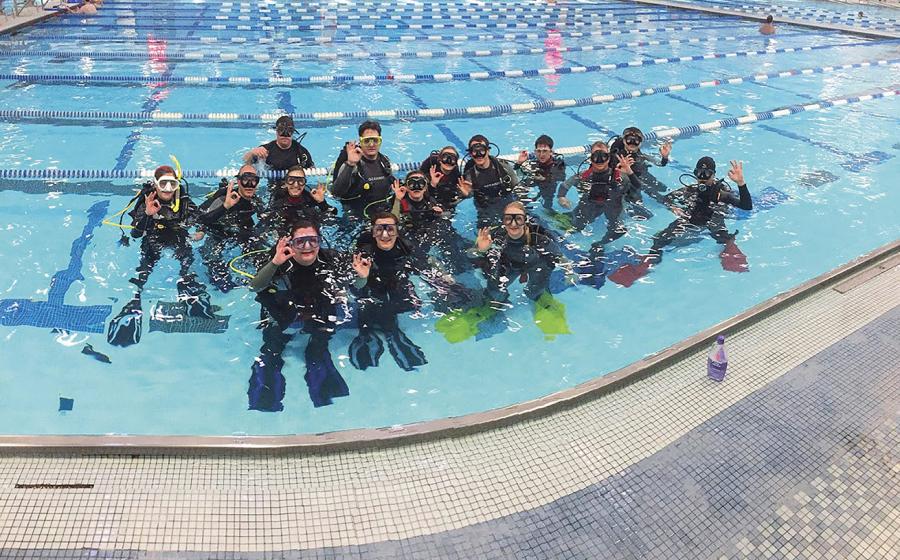Oh Baby! 15 Fantastic Underwater Photos
There is something quite wonderful about seeing juvenile creatures in the ocean. It has become one of the challenges that I have set for myself — to try to photograph animals with their eggs, as well as juveniles that have hatched out, but are much smaller versions of the adults of their species. I dream of actually capturing a hatching as it happens — a rare and lucky shot.
In many cases, the juvenile’s appearance is strikingly different than the mature adult – so much so that it can be a challenge to make a positive identification. Juveniles are often very brightly colored and/or patterned — which seems contrary to logic as you would think it would be better to blend in to the reef so as to avoid notice, but there seems to be a trend that the most colorful animals in the ocean are often the most toxic to eat — nudibranchs (sea slugs) are a great example of this, so perhaps the coloration is perceived as a warning to predators.
Similar to wild animals on land, aquatic creatures have quite varied methods of procreation. Some animals spawn, while others impregnate. Some give birth to live, viable offspring, while others incubate eggs until their fruition. Interestingly, in several species, it is the male that incubates the eggs. As you will see in a couple of my images, some of these males are mouth incubators — that is, they keep the eggs in their mouths until the babies hatch, not feeding for the duration of the gestation. There is some research that suggests that a fair amount of infanticide occurs when the dads swallow some of the eggs – whether by accident or driven by hunger is not known.
Marine mammals, like humans, give birth to live offspring, and tend to nurture the kids, keeping them with them until they are capable of surviving on their own. In killer whale pods, the daughters never leave their mothers, and spend their lives staying connected in their matriarchal pods.
But fish, crustaceans and cephalopods are different — basically once the eggs are hatched (and in some cases long before this point) the parents are usually outta there, and the tiny hatchlings are left to fend for themselves. Typically, these species produce large egg masses, with the reality that very few will survive long in an ocean that is rich with carnivorous critters occupying their link in a complex food chain.
Nesting fish can be quite vicious — with the Titan Triggerfish being the most notorious. These beautiful (and quite hefty) fish are totally benign when they are not nesting, and can be seen poking along the reef, tugging at bits of algae and other tasty tidbits with their big buck teeth. But a Titan Trigger that is nesting is a vicious beast that can take silver dollar sized divots out of divers. And even more perilous — they not only protect their actual nest (which is typically a 3 to 4 foot indentation in the sand), but they also patrol a cone of space above it, all the way to surface. So you can be swimming 30 or more feet away from a nest, and still be relentlessly attacked. We were on such a dive in Indonesia a few years ago. There was a lot of current — so much so that we decided to abort the dive. On the flyover as we ascended, Titan Triggers came up out of what we joked was a mine field of nests below us and attacked. My husband was bitten in the back of the leg (the thing hung on and shook his leg like a dog with a bone!). Fortunately he had a thick wetsuit to protect him, but still, the fish left a serious bruise. I fended off several belligerent beasts with my camera and my fins.
Other pugnacious nesting fish are anemonefish — most especially (in my experience) Panda Anenomefish, plus Damselfish (same family) and Sergeant Majors. So getting in close to capture some images of eggs is not without some peril. :)
More Stellar Photo Blogs from Judy G:
School Daze | Meeting Mr. Little | Meeting Mr. Big | Cold Water Rocks!

Judy G
In this species, it is the male that incubates the eggs, in its mouth. Apparently the fish does not feed for the duration of the gestation, but it has been documented that eggs have been consumed in the process — whether by accident or deliberately is not known.

Judy G
These large mantis shrimp (about 5 inches in length) are quite common in the Indo Pacific. Often they are spotted in their lair —which is typically a small hole or under a tight overhang on the reef. They are ambush predators and pack a very powerful punch with their smashing claw. They would be quite capable of breaking a bone in a hand, or a port on a camera, so a cautious approach is good idea. They can be frustrating to photograph as they tend to disappear into their lair on approach, and may not come out again for a long time. I’ve only seen a couple of these shrimp with their large clutches of eggs — and this was the first that I have seen out and about. It was hunkered in under a tight ledge, which made for a bit of a difficult shot.

Judy G
I’ll admit it: I totally love cephalopods, and cuttlefish are my favorites of that family. These highly expressive, otherworldly animals appear to be highly intelligent and quite social. Catching these two in flagrante delicto was an amazing sight. Cuttlefish mate by coming together in this way, and then the male transfers his sperm pouch to the female. She fertilizes her eggs with it, and then places her eggs in spots on the reef for safekeeping. She’ll tend the eggs by aerating them, and occasionally moving them to put them somewhere that she perceives is a safer spot. I’ve had the good fortune to observe this behavior a couple of times — it really is quite precious.

Judy G
I believe this is a Flamboyant Cuttlefish egg. As I mentioned in the previous image, the female cuttlefish fertilize their eggs, and then put them in cubbies on the reef for safekeeping. You can make out the shape of the baby cuttlefish nestled inside the egg. The egg was about half an inch in diameter.

Judy G
If you’ve been following my stuff here on Scuba Diving's site, you might recall that I am a bit nuts about anemonefish. These lively, colorful little fish are fun to watch, and frustrating to photograph. I was thrilled to find this anemone with glittery eggs coating a small rock beside it. All of the anemonefish on the anemone (there were about six living on it) take turns aerating the eggs, and fending off intruders (like myself).

Judy G
If you want to see eggs, shrimps are a good place to look. More often than not, when I see anemone shrimp (there are several varieties), they will have eggs in their abdomen.

Judy G
This is technically an intermediate fish — so it is in the transition from juvenile (which has a similar coloration but quite different shape) to adult (to which it really bears no resemblance) — the adults in this species are silver and black fish with a flat, dinner plate shape to them.

Judy G
Just when you think it can’t get any weirder, check out these nudibranchs (sea slugs). Nudibranchs are hermaphrodites — which is the scientific term for creatures that have both male and female sex organs. These randy little critters (nudibranchs appear to copulate copiously) plug into each other, and exchange semen. Then they will separate, gestate their eggs, and then each lay an egg mass in a ribbon on the reef.

Judy G
I can’t seem to swim past an anemone with resident fish without at least trying my luck with these flittery characters. And the juveniles are even more frenetic than the adults. But happily, even very tiny anemonefish look just like their parents, so are easy to identify. :)

Judy G
Here is another fish species in which the juveniles look nothing like their parents. I don’t have a resource that specifically identifies the juvenile versions of fish, so I can’t say what this little cutie is, other than I am fairly sure it is a filefish. It was about a half inch in diameter.

Judy G
Jawfish are another mouth-incubating species, and again, it is the male that tends the eggs. These jawfish are quite common in the Caribbean, but finding one with eggs is a bit of a treasure hunt, and actually getting a shot of one with eggs requires quite a bit of patience, as these fish tend to retreat into the holes in the sand in which they live when divers approach.

Judy G
This little cutie is another species that in no way resembles the adult fish it will become. There is a wide variety of coloration in the adults, but junior always has this clown-like pattern and color.

Judy G
I’ve only seen one of these sharks, and again, its coloration is wildly different than the adults in the family, which are quite dull and dusky.

Judy G
I mentioned in an earlier caption that nudibranchs are hermaphrodites. The result of that copulation is an egg ribbon or cluster — which are masses of eggs extruded from the animal in a mucous-like substance that binds them together. This Glossodoris is actually in the act of squeezing out its egg ribbon.

Judy G
Ah, baby Nemo! Cutest fish in the sea?
There is something quite wonderful about seeing juvenile creatures in the ocean. It has become one of the challenges that I have set for myself — to try to photograph animals with their eggs, as well as juveniles that have hatched out, but are much smaller versions of the adults of their species. I dream of actually capturing a hatching as it happens — a rare and lucky shot.
In many cases, the juvenile’s appearance is strikingly different than the mature adult – so much so that it can be a challenge to make a positive identification. Juveniles are often very brightly colored and/or patterned — which seems contrary to logic as you would think it would be better to blend in to the reef so as to avoid notice, but there seems to be a trend that the most colorful animals in the ocean are often the most toxic to eat — nudibranchs (sea slugs) are a great example of this, so perhaps the coloration is perceived as a warning to predators.
Similar to wild animals on land, aquatic creatures have quite varied methods of procreation. Some animals spawn, while others impregnate. Some give birth to live, viable offspring, while others incubate eggs until their fruition. Interestingly, in several species, it is the male that incubates the eggs. As you will see in a couple of my images, some of these males are mouth incubators — that is, they keep the eggs in their mouths until the babies hatch, not feeding for the duration of the gestation. There is some research that suggests that a fair amount of infanticide occurs when the dads swallow some of the eggs – whether by accident or driven by hunger is not known.
Marine mammals, like humans, give birth to live offspring, and tend to nurture the kids, keeping them with them until they are capable of surviving on their own. In killer whale pods, the daughters never leave their mothers, and spend their lives staying connected in their matriarchal pods.
But fish, crustaceans and cephalopods are different — basically once the eggs are hatched (and in some cases long before this point) the parents are usually outta there, and the tiny hatchlings are left to fend for themselves. Typically, these species produce large egg masses, with the reality that very few will survive long in an ocean that is rich with carnivorous critters occupying their link in a complex food chain.
Nesting fish can be quite vicious — with the Titan Triggerfish being the most notorious. These beautiful (and quite hefty) fish are totally benign when they are not nesting, and can be seen poking along the reef, tugging at bits of algae and other tasty tidbits with their big buck teeth. But a Titan Trigger that is nesting is a vicious beast that can take silver dollar sized divots out of divers. And even more perilous — they not only protect their actual nest (which is typically a 3 to 4 foot indentation in the sand), but they also patrol a cone of space above it, all the way to surface. So you can be swimming 30 or more feet away from a nest, and still be relentlessly attacked. We were on such a dive in Indonesia a few years ago. There was a lot of current — so much so that we decided to abort the dive. On the flyover as we ascended, Titan Triggers came up out of what we joked was a mine field of nests below us and attacked. My husband was bitten in the back of the leg (the thing hung on and shook his leg like a dog with a bone!). Fortunately he had a thick wetsuit to protect him, but still, the fish left a serious bruise. I fended off several belligerent beasts with my camera and my fins.
Other pugnacious nesting fish are anemonefish — most especially (in my experience) Panda Anenomefish, plus Damselfish (same family) and Sergeant Majors. So getting in close to capture some images of eggs is not without some peril. :)
More Stellar Photo Blogs from Judy G:
School Daze | Meeting Mr. Little | Meeting Mr. Big | Cold Water Rocks!










